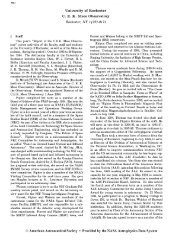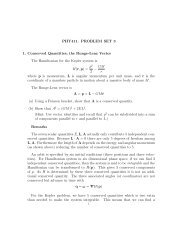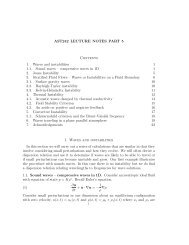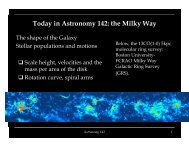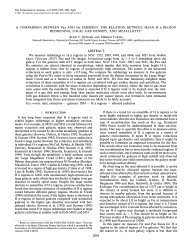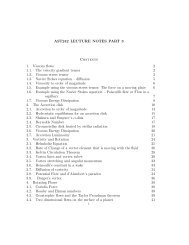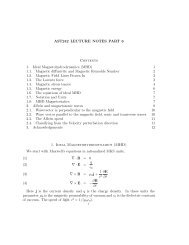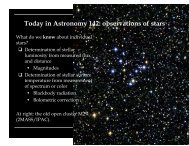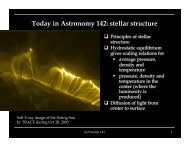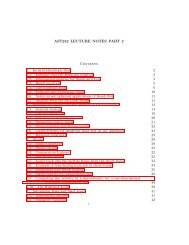Development of infrared focal plane arrays for space - Astro Pas ...
Development of infrared focal plane arrays for space - Astro Pas ...
Development of infrared focal plane arrays for space - Astro Pas ...
Create successful ePaper yourself
Turn your PDF publications into a flip-book with our unique Google optimized e-Paper software.
<strong>Development</strong> <strong>of</strong> <strong>infrared</strong> <strong>focal</strong> <strong>plane</strong> <strong>arrays</strong> <strong>for</strong> <strong>space</strong>Jian Wu, William J. Forrest, Judith L. Pipher, Nancy Lum, and Alan H<strong>of</strong>fmanCitation: Rev. Sci. Instrum. 68, 3566 (1997); doi: 10.1063/1.1148324View online: http://dx.doi.org/10.1063/1.1148324View Table <strong>of</strong> Contents: http://rsi.aip.org/resource/1/RSINAK/v68/i9Published by the American Institute <strong>of</strong> Physics.Related ArticlesPrototype system <strong>for</strong> superconducting quantum interference device multiplexing <strong>of</strong> large-<strong>for</strong>mat transition-edgesensor <strong>arrays</strong>Rev. Sci. Instrum. 74, 4500 (2003)A photometric imaging solar telescope, tunable in the extreme ultraviolet, utilizing multilayer x-ray opticsRev. Sci. Instrum. 73, 1908 (2002)X-ray observations and analysis with the Chandra X-ray observatory (abstract)Rev. Sci. Instrum. 72, 1166 (2001)Preamplifier and AD converter system <strong>for</strong> <strong>infrared</strong> <strong>focal</strong> <strong>plane</strong> <strong>arrays</strong>Rev. Sci. Instrum. 71, 3921 (2000)Automatization <strong>of</strong> a multipurpose astronomical spectrographRev. Sci. Instrum. 71, 2598 (2000)Additional in<strong>for</strong>mation on Rev. Sci. Instrum.Journal Homepage: http://rsi.aip.orgJournal In<strong>for</strong>mation: http://rsi.aip.org/about/about_the_journalTop downloads: http://rsi.aip.org/features/most_downloadedIn<strong>for</strong>mation <strong>for</strong> Authors: http://rsi.aip.org/authorsDownloaded 21 Jun 2012 to 128.151.144.191. Redistribution subject to AIP license or copyright; see http://rsi.aip.org/about/rights_and_permissions
<strong>Development</strong> <strong>of</strong> <strong>infrared</strong> <strong>focal</strong> <strong>plane</strong> <strong>arrays</strong> <strong>for</strong> <strong>space</strong>Jian Wu, William J. Forrest, and Judith L. PipherUniversity <strong>of</strong> Rochester, Rochester, New York 14627Nancy Lum and Alan H<strong>of</strong>fmanSanta Barbara Research Center, Goleta, Cali<strong>for</strong>nia 93117Received 10 October 1996; accepted <strong>for</strong> publication 16 June 1997Space astronomy requires large-area cryogenic <strong>infrared</strong> <strong>focal</strong> <strong>plane</strong> <strong>arrays</strong> FPAs with highquantum efficiency, extremely low dark current, low power dissipation, and background limitednoise per<strong>for</strong>mance. To meet these requirements, especially at temperatures <strong>of</strong> 5–15 K, SantaBarbara Research Center designed and fabricated a new multiplexer, CRC-744. The FPAs made bybonding InSb detector <strong>arrays</strong> to CRC-744 multiplexers were evaluated at the University <strong>of</strong>Rochester. The best array achieved the read noise <strong>of</strong> 5 e with 12 s integration and 7 e with 200s integration with Fowler-64 sampling at 15 K, the average dark current <strong>of</strong> 0.2 e /s at both 15 and29 K, and the average quantum efficiency <strong>of</strong> 87% at both 15 and 29 K. The 10%–90% rise time was4 s driving a 600 pF external load. The power dissipation was 0.3–0.4 mW when running flat-out100% duty cycle. The full well capacity was 10 5 e 230 mV with 400 mV <strong>of</strong> applied bias. Theabove test results demonstrate that the FPAs meet background-limited <strong>space</strong> experimentrequirements. The CRC-744 multiplexer works well down to at least 5 K the lowest temperature <strong>of</strong>our tests. © 1997 American Institute <strong>of</strong> Physics. S0034-67489702709-3I. INTRODUCTIONCryogenic <strong>space</strong> telescopes such as the Space InfraredTelescope Facility SIRTF require large-area <strong>focal</strong> <strong>plane</strong> <strong>arrays</strong>FPAs with high sensitivity. Of course, the detectormaterial must exhibit high quantum efficiency QE, and ultralowdark current—in fact, the dark current must be negligiblewith respect to the zodiacal background photocurrent.In addition, the FPAs must be background-limited <strong>for</strong> SIRTFapplication. This implies that the read noise must be muchless than that given by fluctuations in the number <strong>of</strong> backgroundphotons detected. This latter constraint places largedemands on readout <strong>arrays</strong> to simultaneously provide lownoise and high responsivity at low power dissipation. 1,2Santa Barbara Research Center SBRC has developed alow-noise 256256 pixel Si readout, the CRC-744, designed<strong>for</strong> low temperature (5 – 15 K) operation. In the applicationdiscussed here, an InSb 1–5.5 m detector array isbump-bonded to the CRC-744 multiplexer mux to <strong>for</strong>m theFPA, as contracted by the SIRTF Infrared Array CameraIRAC team. The CRC-744 will also be used with Si:Asimpurity band conduction IBC <strong>arrays</strong> <strong>for</strong> IRAC, and couldbe used with visible fine guidance sensors FGS.The unit cell employs a switched source-follower-perdetectorSFD design wherein signals are multiplexed ont<strong>of</strong>our outputs while row and column scanners can flexiblyaddress small block portions <strong>of</strong> the array to conserve power.The data <strong>for</strong> this article are from readouts developed undercontract to the IRAC team, which have been fabricated usingan optimized cryo-complementary metal-oxide semiconductorcryo-CMOS process developed at Hughes <strong>for</strong>merlyHTC specifically <strong>for</strong> low temperature. This process is currentlyavailable at the Hughes Microelectronics Division.Since previous generation readouts employed by SBRC hadbeen developed <strong>for</strong> higher temperatures e.g., the popularCRC-463, which exhibits fairly good noise characteristics attemperatures 30 K used in the SBRC commercial astronomyarray program, and <strong>for</strong> previous SIRTF developmental<strong>arrays</strong>, our program goal was to achieve superiornoise per<strong>for</strong>mance at 5–15 K. As discussed in detail below,we have achieved impressive read noise (5 e ), as well asexcellent quantum efficiency and dark current <strong>for</strong> these InSbFPAs. Staring FPAs designed <strong>for</strong> astronomy have made impressiveprogress in the decade. Figure 1 illustrates the improvementin read noise at various temperatures <strong>for</strong> SBRCastronomy FPAs.II. DESCRIPTION OF THE InSb FPASA. The InSb <strong>arrays</strong>The detectors are 256256 element, back-illuminatedphotovoltaic indium antimony InSb <strong>arrays</strong> constructed <strong>of</strong>Firebird undoped (10 14 cm 3 ) and low doped (210 14 cm 3 ) material. The elements are <strong>space</strong>d on 30 mcenters in both dimensions <strong>of</strong> the two-dimensional array, andthe optically active area <strong>of</strong> each element is (30 m) 2 , thatis, the fill factor is nearly 100%. Each array has an antireflectioncoating applied to the light-incident surface to improvequantum efficiency. Low temperature response uni<strong>for</strong>mityhas been enhanced by tight control <strong>of</strong> the detectorthickness with a goal <strong>of</strong> 71 m.B. CRC-744 readout descriptionThe Si readout is connected to a detector array by indiumbump contacts on 30 m centers to create a <strong>focal</strong> <strong>plane</strong>array FPA. Figure 2 illustrates the 256256 amplifiers <strong>for</strong>integrating detector current. Each unit cell contains a sourcefollower which allows the array to be read out nondestructively,that is, the voltage can be sampled without losing theintegrated signal. Every fourth column is multiplexed to one<strong>of</strong> four outputs. There is a fast scanner which multiplexes the3566 Rev. Sci. Instrum. 68 (9), September 1997 0034-6748/97/68(9)/3566/13/$10.00 © 1997 American Institute <strong>of</strong> PhysicsDownloaded 21 Jun 2012 to 128.151.144.191. Redistribution subject to AIP license or copyright; see http://rsi.aip.org/about/rights_and_permissions
FIG. 1. Read noise <strong>for</strong> SBRC astronomy SCAs over the last decade.signal from the columns and a slow scanner that enables therows. There are eight clocks and ten biases required <strong>for</strong> theoperation <strong>of</strong> the FPA.There are two features built into the architecture <strong>of</strong> thisdevice. The first feature is the nondestructive read, which isnecessary <strong>for</strong> multiple sampling, as required <strong>for</strong> low readnoise. 3–5 The second feature is the flexibility <strong>of</strong> the scanners.The design <strong>of</strong> the scanners allows <strong>for</strong> the capability <strong>of</strong> accessingdata <strong>for</strong> the full array as well as a subarray, simplyby adjusting the clocking pattern. It is possible to burst to thedesired row or column, read that portion, and then eitherburst again to the end or terminate the scan and reset the shiftregisters. The development <strong>of</strong> the CRC-744 built upon thesuccess <strong>of</strong> the CRC-463 readout, which is also a SFDreadout. 6,7Major changes incorporated into the present readout inboth the processing and design were made to reduce noise atthe desired low temperature. Changes in fabrication includedboth starting material and processing steps. Since freeze-outat these low temperatures is a well known cause <strong>of</strong> increasedread noise as in Fig. 2 <strong>of</strong> Ref. 7 when T25 K, itwasimportant to address all the possible improvements needed tomitigate this phenomenon. In addition to theoretical analysis,actual lot splits which varied both the starting material andthe processing were made to confirm the hypotheses: thefinal SIRTF design readout was chosen from these lot splits.The splits were distributed to give both good yield <strong>for</strong> themost optimal process and to also confirm the mechanisms <strong>for</strong>per<strong>for</strong>mance enhancement.The most significant design changes made were in theFIG. 2. CRC-744 readout.FIG. 3. CRC-744 unit cell.Rev. Sci. Instrum., Vol. 68, No. 9, September 1997IR <strong>focal</strong> <strong>plane</strong> <strong>arrays</strong>3567Downloaded 21 Jun 2012 to 128.151.144.191. Redistribution subject to AIP license or copyright; see http://rsi.aip.org/about/rights_and_permissions
TABLE II. Clock settings.Clocks Active V Inactive VFIG. 4. Schematic showing the output from one pixel vs time and thecorrelated triple sampling SRP mode. S, R, and P refer to the signal, reset,and pedestal levels. In this mode, four levels P1, R1, S2, and R2 aresampled and the combination (S2R2)(P1R1) is recorded, where P1and R1 refer to the pedestal and reset levels in the beginning frame and S2and R2 refer to the signal and reset levels in the end frame. However, since256 unit cells in each row <strong>of</strong> CRC-744 are reset together, it is only possibleto per<strong>for</strong>m true correlated triple sampling on the first four unit cells in eachrow.unit cell itself see Fig. 3. The configuration was from a fourtransistor architecture as in the CRC-644 and CRC-463multiplexers to a three transistor architecture as in theSBRC Aladdin 10241024 readout, SBRC-084. With thisdesign, the unit cells are reset by row. This minimizes thetime necessary to reset the whole array about 25615 s,which is advantageous <strong>for</strong> ‘‘Fowler’’ or sampling up theramp SUR nondestructive multiple sampling. 3,8 However,it is not possible to per<strong>for</strong>m correlated double or triple samplingsee Fig. 4 with this architecture in the same way aswith the CRC-463. A new program was written to clock theCRC-744 multiplexers muxes in Fowler sampling mode.However, as discussed in Sec. III, we used the CRC-463clock program to make noise measurements in correlatedtriple sampling mode. A further modification was the inclusion<strong>of</strong> a clamp circuit V ggcl and V ddcl in Fig. 3. This reducesthe clock feed-through to the detector integrating node.III. EVALUATION OF MUX LOT SPLITSFour CRC-744 muxes were tested, one from each <strong>of</strong> thelow temperature optimized splits Lawrence 2 m process,Lawrence 3 m process, standard cryo-CMOS process, andTRW 2 m process. The tested muxes are listed in Table I.There was a fifth split, optimized <strong>for</strong> operation at T30 K,which has not been tested. rst 5.5 3.0 syncS 7.0 1.0 1S 7.0 1.0 2S 7.0 1.0 syncF 4.0 1.0 1F 4.0 1.0 2F 4.0 1.0 ggcl 5.0 1.0The first activity was to determine the clock patterns,clock voltages, and bias voltages to employ <strong>for</strong> best per<strong>for</strong>mance.The initial voltages and currents utilized came fromthe engineering design see Tables II and Tables III. Therewere two areas <strong>of</strong> special concern. First, it was necessary todetermine whether to use the current source per frame P1, orthe current source per column P38 see Fig. 3, to supplycurrent to the unit cell amplifiers and second, it was necessaryto determine how large the current should be. The designspecifies each P38, which uses the current from V gg1 asthe reference current and provides 1 A; and P1, which usesthe current from V gg2 as the reference current and provides 1or possibly 10 A. In turn, the current from V gg1 should be4 A and the current from V gg2 should be 4 or possibly 40A. A 400 k resistor was used with V gg1 anda40kresistor was used with V gg2 . Initial operation <strong>of</strong> the first muxat room temperature indicated better uni<strong>for</strong>mity from row torow using P1 rather than P38. However later, when operatingat T6 K, we observed a significant anomaly, namelythat the signal level in the correlated triple sampling modewas 0.3 V higher than the pedestal level, with no illumination<strong>of</strong> the mux. These two levels should be approximatelyequal. It was found that turning V gg2 <strong>of</strong>f 0 Vand V gg1 on(3 V) cured this problem, and also gave a much moreuni<strong>for</strong>m Reset level. We concluded that the current sourceper column P38 gave superior per<strong>for</strong>mance. All the testsreported here used this current source. In addition, V dduc ,V ddout , and rst were also changed from 3.0, 1.0, and2.0/4.5 V to 3.5, 1.2, and 3.0/5.5 V, respectively,to improve dynamic range. Later in the FPA tests,when the gate protection Zener diode was replaced by a 1M resistor, V gg1 was adjusted to give a reasonable waveTABLE I. Test summary <strong>of</strong> CRC-744 bare muxes.Lawrence 2 mLawrence 3 mCryo-Std.CMOSTRW 2 mWafer No. 17 20 08 14R-P charge dump V0.28 0.32 0.32 0.30output referredTime constant s2.4 2.4 2.4 2.4rising, 5%–70%Time constant s0.7 0.6 0.7 0.6falling, 70%–5%dc gain 0.827 0.873 0.863 0.827Dynamic range <strong>of</strong> V rstuc V 3.85 to 2.75 3.75 to 2.75 3.95 to 2.95 3.9 to 2.9Current <strong>of</strong> V gg1 A ••• 4.2 4.0 •••Current V gg2 A 0 0 0 03568 Rev. Sci. Instrum., Vol. 68, No. 9, September 1997 IR <strong>focal</strong> <strong>plane</strong> <strong>arrays</strong>Downloaded 21 Jun 2012 to 128.151.144.191. Redistribution subject to AIP license or copyright; see http://rsi.aip.org/about/rights_and_permissions
TABLE III. Bias setting.Biases Volt I park A a I flat A aV gg14.2 bV gg2 0.0V dduc 3.5 105V ssS 1.0V ssF 1.0V ddcl 1.9 105V ddout 1.2 260 270V ss1 ,V ss2 1.0 105 105V rstuc 3.5V detcV rstuc V biasV sub 0.0a Only currents more than 20 A are noted.b To provide 3.0 V at the chip carrier.c V bias is the applied back bias voltage across the photodiodes. For baremuxes. V bias 0 V. For CRC744-40716, V bias 400 mV.<strong>for</strong>m and dynamic range at the output, while maintaining lowpower dissipation. The unit cell current employed was about0.4 A. In Table III, the V dduc current when running flat outis the sum <strong>of</strong> the unit cell current from 256 unit cells. Thisis considerably lower than the 1 A employed <strong>for</strong> the baremux tests. In Table I, the V gg1 current is four times the unitcell current. This may explain the improved stability observedwith the FPAs compared with the bare muxes.The next significant problem was resetting in the Fowlersampling mode: in this mode, the array is reset and the average<strong>of</strong> n pedestal levels are subtracted from the average <strong>of</strong>n signal levels in the same integration ramp. The techniqueinitially used was to hold the reset clock on while clockingthrough all the rows, then turning it <strong>of</strong>f. However, it wasfound that the Fowler pedestal and signal levels were significantlydifferent from those seen in the correlated triple samplingmode, which cannot be correct. It was found thatproper resetting in the Fowler sampling mode required selectinga row, then turning the reset clock on <strong>for</strong> 15 s,then turning it <strong>of</strong>f, then selecting the next row. With thisclocking, the Fowler pedestal and signal levels were quitecomparable to those seen with correlated triple sampling. Ifone studies the schematic <strong>for</strong> the unit cell in Fig. 3, it makessense that just holding the reset clock ON while enablingsucceeding rows is not a good idea, since this could leave thereset field-effect transistor FET <strong>of</strong> each unit cell in an ONstate. After resetting, we want this FET to be in the OFFstate, to allow the integrating node to debias from dark currentand photocurrent.The tests concentrated on the Fowler sampling mode. Asshown in Figs. 5c and 5d, this mode can lead to significantlyreduced noise. All previous muxes we have testedshowed poor per<strong>for</strong>mance in Fowler sampling mode at temperaturesbelow about 23 K. 7 We also measured noise in thecorrelated triple sampling mode signal-reset-pedestal SRPmode in our s<strong>of</strong>tware to compare with previous measurements<strong>of</strong> the CRC-590 and 644 muxes and also to evaluatethis mode at low temperatures, in case the Fowler samplingmode proved to be unstable as it had <strong>for</strong> the CRC-590 and644 muxes. Finally, the reset mode R-G in our s<strong>of</strong>twarewas also tested to check out the noise <strong>of</strong> the FETs with theunit cell gate the gate <strong>of</strong> P2 in Fig. 3 held at the resetvoltage V rstuc . In Fowler and correlated triple samplingmodes, we are sensitive to noise with that gate floating thereset FET turned <strong>of</strong>f.For correlated triple sampling Fig. 4 and R-G modes,our old clock program <strong>for</strong> the CRC-463, 590, and 644 wasused. This would not be correct <strong>for</strong> actual array operation,since each unit cell is being reset 64 times, and only the firstfour pixels in each row have the correct integration time.However, we believe this to be a reasonable expedient whenthere is no signal or dark current, and we are just measuringthe noise. When checking <strong>for</strong> response to visible light in theSRP mode, only the first four pixels <strong>of</strong> each row showed alarge response.The procedure employed was to cool to 5.5 K. Thenthe steps followed were:1 operate the mux and confirm reasonable operation;2 check the last row and last column diagnostic lines toverify correct operation <strong>of</strong> the shift registers;3 measure the gain by measuring the output voltage as afunction <strong>of</strong> the reset voltage (V rstuc );4 shine optical light on the array and verify reasonableresponse positive signals were seen;5 take data with 6 s integration times as the Dewar warmsup liquid helium runs out.Two frames <strong>of</strong> data each in the SRP, R-G, Fowler-1,Fowler-8, and Fowler-32 were acquired Fowler-n refers toFowler sampling with n pairs <strong>of</strong> samples. Successive framesin the same mode were subtracted and a 2525 region nearthe center <strong>of</strong> the array was analyzed. After correcting <strong>for</strong> the& factor <strong>for</strong> the two data frames, the rms noise in this regiongives the pixel read noise. The average difference betweenthe two frames, which should be close to zero, was examinedin order to investigate instability, commonly seen in Fowlersampling mode at the lower temperatures. The bias framesshort integration dark current frames were also studied.Bias frames should be zero <strong>for</strong> Fowler mode; nonzero valuesindicate some instability. The SRP bias frame should also beclose to zero. The R-G bias frame includes an arbitrary dc<strong>of</strong>fset. It is examined to look <strong>for</strong> any drastic shifts in theoperating point <strong>of</strong> the FETs, <strong>for</strong> example, caused by freezeout.The 2525 region examined was positioned near arraycenter. For Lawrence 2 m material and TRW 2 m material,it was centered at row,column128,128. For theother two muxes it was centered at row,column100,100to avoid a bad pixel. The conversion from measured ADUsto voltage referred to the input was based on the measureddc gain, our gain <strong>of</strong> 20 preamplifiers, and the fact that 10-V<strong>for</strong> our analog digital converters ADCs gives 32 768 analogdigital units ADUs. The conversion to electrons was basedon the estimated node capacitance without detectors <strong>of</strong> 27.7fF from the engineering design. Figure 5 shows the noisemeasurement results. Figure 6 illustrates the instability testresults <strong>for</strong> Fowler mode with 32 sample pairs.From our bare mux data, Lawrence 2 m material appearedto be superior. Above 18 K, Fowler sampling modesappear well-behaved and the noise with 32 pairs <strong>of</strong> samplesRev. Sci. Instrum., Vol. 68, No. 9, September 1997IR <strong>focal</strong> <strong>plane</strong> <strong>arrays</strong>3569Downloaded 21 Jun 2012 to 128.151.144.191. Redistribution subject to AIP license or copyright; see http://rsi.aip.org/about/rights_and_permissions
FIG. 5. Read noise vs temperature in SRP mode, R-G mode, and Fowler mode with one sample pair and Fowler mode with 32 sample pairs <strong>for</strong> Lawrence 2m, Lawrence 3 m, standard cryo-CMOS, and TRW 2 m muxes.is about 4 e or 27 V. Below 18 K, there was some instabilityin the Fowler modes. Lawrence 3 m material was thenext best, although it has somewhat higher noise and moreinstability in the SRP mode. Lawrence 2 m and Lawrence 3m materials originate from the same manufacturer, differingonly in epitaxial thickness. Standard cryo-CMOS materialwas well behaved in the SRP mode, but shows substantialinstability in the Fowler mode. We compared itsper<strong>for</strong>mance to CRC-590 and 644 muxes we have testedearlier also standard cryo-CMOS and they are roughlycomparable. TRW 2 m material per<strong>for</strong>med well in the SRPmode. It was reasonably good above 15 K in Fowler modes,but showed an annoying noise peak at 25 K. Below 15 K, theinstability in the Fowler mode was a little larger than <strong>for</strong> theLawrence materials.IV. FPA TESTSSBRC indium bump-bonded low doped (1.7– 2.010 14 cm 3 ) and undoped (1.010 14 cm 3 ) FirebirdInSb to CRC744 muxes <strong>for</strong>med from Lawrence 2 m andLawrence 3 m materials. The best six FPAs using CRC-744 muxes and InSb detectors have been tested at the University<strong>of</strong> Rochester. Tests <strong>of</strong> noise, mux stability, and QEwere made as the Dewar warmed up from 5 to 50 K, afterexhaustion <strong>of</strong> the LHe supply exactly as described <strong>for</strong> thebare mux tests. For noise and mux stability tests, the detector3570 Rev. Sci. Instrum., Vol. 68, No. 9, September 1997 IR <strong>focal</strong> <strong>plane</strong> <strong>arrays</strong>Downloaded 21 Jun 2012 to 128.151.144.191. Redistribution subject to AIP license or copyright; see http://rsi.aip.org/about/rights_and_permissions
FIG. 7. The reset voltage measured at the output amplifiers vs the resetvoltage applied to the integrating node at 14.5 K <strong>for</strong> FPA CRC 744-40716.FIG. 6. Instability in Fowler mode with 32 sample pairs.viewed our cold dark slide. For the QE tests, data were takenthrough a 3.3 m filter viewing the laboratory. It took about30 min <strong>for</strong> the <strong>arrays</strong> to warm up from 10 to 20 K duringwhich time 12 data sets were acquired. More detailed andaccurate tests <strong>of</strong> read noise, QE, and dark current were madewith the temperature stabilized around 14.5 and 28.5 K. Theoperating voltages and currents <strong>for</strong> the <strong>arrays</strong> are presentedin Tables II and III.The FPA per<strong>for</strong>mance was more stable than that <strong>of</strong> thebare muxes. They showed smaller differences between twosuccessive frames in the same mode and smaller Fowler‘‘bias’’ frame values than the bare muxes. Most <strong>of</strong> the FPAsshowed low noise, small dark current, and high QE. TheFPAs made from Lawrence 2 m muxes had hundreds <strong>of</strong> e <strong>of</strong> dark charge in the dark images, which caused unexplainednonlinearity in dark current versus integration time curves. Inaddition, some FPAs made from Lawrence 2 m muxesshowed a quite wide distribution <strong>of</strong> zero bias points, whichrequired operation at very high applied detector bias 800and 1250 mV. There<strong>for</strong>e, the FPAs made from Lawrence 3m muxes were judged to give better overall per<strong>for</strong>mance.Among all the FPAs, CRC744-40716, which has aLawrence 3 m mux bonded to a Firebird low doped InSbarray, exhibits the best overall per<strong>for</strong>mance. Its best readnoise <strong>of</strong> 5 e was obtained using the Fowler sampling modewith 64 sample pairs at 15 K. The dark current images <strong>for</strong>this array were reasonably uni<strong>for</strong>m and there were only a fewhot pixels. At both 14.5 and 28.5 K, the 3 upper limit to thedark current was 0.2 e /s/pixel. The average quantum efficiencyin the whole array is 87% at both 14.5 and 28.5 K.The central part <strong>of</strong> the array has somewhat lower quantumefficiency 78% at 14.5 K and 82% at 28.5 K and it decreaseswhen the temperature is reduced. This behavior isanomalous, and is under current investigation. The powerdissipation and load driving capability at 14.5 K was alsomeasured <strong>for</strong> this array.The following discussions will concentrate on CRC744-40716.A. CalibrationThe dc gain <strong>of</strong> the multiplexer was determined from theslope <strong>of</strong> the reset level measured at the output amplifiersversus the reset voltage applied to the integrating node seeFig. 7. At both 14.5 and 28.5 K, it was 0.87 throughout thewhole array.To calibrate our voltages to the charge collected on theintegrating node, the noise 2 versus signal method was used.The read noise in Fowler mode with one sample pair and thesignal were measured in three 2525 pixel boxes. The slope<strong>of</strong> the noise 2 versus signal gives the system gain in ADU/e .This in<strong>for</strong>mation, in conjunction with the dc gain measurementwhich gives the conversion ADU/V, determines thetotal capacitance <strong>of</strong> the integrating node.The noise 2 versus signal curve was measured at both14.5 and 28.5 K. Figure 8 shows the data obtained at 14.5 K.The capacitances calculated within three 2525 boxes centeredat column,row(x,y)(50,50), 128,128, and225,225 are summarized in Table IV. Since the capacitanceRev. Sci. Instrum., Vol. 68, No. 9, September 1997IR <strong>focal</strong> <strong>plane</strong> <strong>arrays</strong>3571Downloaded 21 Jun 2012 to 128.151.144.191. Redistribution subject to AIP license or copyright; see http://rsi.aip.org/about/rights_and_permissions
FIG. 8. Read noise squared vs signal at 14.5 K and three (x,y) positions on FPA CRC744-40716. The slope <strong>of</strong> the straight line fit is converted to unit cellcapacitance and e /ADU in Table IV.is a function <strong>of</strong> the bias voltage, when the signal increasesthe noise 2 versus signal curve deviates from a straight line.Thus, only the data points with signal 1500 ADU wereused <strong>for</strong> curve fitting.The capacitance does not change much between the twotemperatures except in the box at 50,50 which includessome early <strong>for</strong>ward biased pixels at 28.5 K. There<strong>for</strong>e, thecapacitances at 14.5 K were used in the calculations <strong>for</strong> bothtemperatures and an average capacitance <strong>of</strong> 0.069 pF wasused <strong>for</strong> the whole array.It is appropriate to use the capacitance obtained above tocalculate the dark current or the read noise, since the signal isusually small <strong>for</strong> those measurements. However, <strong>for</strong> the QEmeasurement with a signal <strong>of</strong> about 3500–4000 ADUs, thechange in capacitance caused by the detector discharge hasto be considered.The array is inherently nonlinear because the nodal capacitanceincreases as the InSb diodes discharge toward zerobias. We calibrate this effect by observing the signal, thechange <strong>of</strong> the voltage across a detector caused by a constantlight source, as a function <strong>of</strong> integration time t. For a constantdischarge current, the signal is proportional to t and1/C, where C is the nodal capacitance. When normalized toits maximum value at zero signal, it gives C 0 /C as a function<strong>of</strong> signal as shown in Fig. 9, where C 0 is the nodalcapacitance at zero signal. It is evident that C 0 /C is not aconstant, which indicates the nonlinearity. The abrupt dropabove 12 000 ADU in C 0 /C results from detector saturation.We fit this curve be<strong>for</strong>e saturation to a straight line and usethe curve-fitting results to determine the capacitance used <strong>for</strong>the QE calculation. The small signal capacitance quoted earlierwas obtained by fitting the data with signals <strong>of</strong> 0–1500ADUs Fig. 8. The capacitance <strong>of</strong> 7.6 e /ADU obtained bythe above fitting is good <strong>for</strong> the signal level around 600ADUs. At 4000 ADUs, the approximate signal in the QE flatfield, the capacitance is estimated to be 8.0 e /ADU.B. Zero bias point and well depthTo obtain the zero bias voltage the array was exposed toa low level photon flux until it was saturated. The level <strong>of</strong> thephoton flux was kept low in order to minimize the influence<strong>of</strong> the additional <strong>for</strong>ward bias, caused by the photon flux, onthe accuracy <strong>of</strong> the test results. A K filter ( 0 2.23 m)and room illumination <strong>of</strong> the array were used <strong>for</strong> this purpose.The time to saturate was about 60 s at 14.6 K and about40 s at 28.5 K. The amount <strong>of</strong> signal collected with low levelTABLE IV. Capacitance pF at 400 mV applied bias.T K 50,50 128,128 225,225 Average14.5 0.067 (7.3e /ADU) 0.071 (7.7e /ADU) 0.070 (7.6e /ADU) 0.069 (7.6e /ADU)28.5 0.050 (5.5e /ADU) 0.074 (8.1e /ADU) 0.069 (7.6e /ADU) •••3572 Rev. Sci. Instrum., Vol. 68, No. 9, September 1997 IR <strong>focal</strong> <strong>plane</strong> <strong>arrays</strong>Downloaded 21 Jun 2012 to 128.151.144.191. Redistribution subject to AIP license or copyright; see http://rsi.aip.org/about/rights_and_permissions
TABLE V. Well depth W.D. and zero bias point Z.B.P. at 400 mVapplied bias.T K W.D. ADU W.D. (e ) W.D. VZ.B.P.VWhole array 14.6 1.2910 4 1.0310 5 0.23 0.172525 Central box 14.6 1.3510 4 1.0810 5 0.24 0.16Whole array 28.5 1.0 10 4 8.0 10 4 0.18 0.222525 Central box 28.5 1.1 10 4 8.8 10 4 0.19 0.21TABLE VI. Quantum efficiency % at 400 mV bias.Whole array2525 box at 128,128T14.6 K 87 78T28.5 K 87 82FIG. 9. Measurements <strong>of</strong> FPA CRC744-40716 nonlinearity: C 0 /C vs signallevel, C is the nodal capacitance as a function <strong>of</strong> signal and C 0 is the nodalcapacitance at zero signal.saturation is the well depth. The zero bias point is simply thewell depth subtracted from the applied bias.The well-depth data under 400 mV applied bias at 14.6and 28.5 K are summarized in Table V. Well depth decreasesas temperature increases. The average zero bias point <strong>of</strong> thewhole array is a little higher than that <strong>of</strong> the central box.C. Quantum efficiencyFigures 10 through 13 show flat-field images and QEhistograms at 14.5 and 28.5 K, and the data are summarizedin Table VI. The data were taken at an applied bias <strong>of</strong> 400mV, a 0.172 s integration time, and using a 3.256 m broadbandfilter (0.220 m). The optical area was assumedto be (30 m) 2 i.e., 100% fill factor. The flat field imagesare fairly uni<strong>for</strong>m across the whole array. However, some‘‘tree-rings’’ intrinsic to the InSb array can be seen and thecentral part has lower quantum efficiency. The average quantumefficiency at 14.5 K is 87% <strong>for</strong> the whole array and 78%in the central 2525 box see Table VI. The average quantumefficiency at 28.5 K is 87% <strong>for</strong> the whole array and 82%in the central 2525 box. Figure 14 shows the quantumefficiency versus temperature <strong>for</strong> the central 2525 box andthe whole array.D. Dark currentImages <strong>of</strong> the cold dark slide at different integrationtimes were taken in the Fowler mode with 32 sample pairs at14.5 and 28.5 K. Dark signal data obtained from a 2525box at the center <strong>of</strong> the array, in which there are no hotpixels, are presented in Table VII. No Fowler bias has beensubtracted.By fitting the data in Table VII to straight lines, the slopeis found to be 0.010.04 e /s at 14.7 K and 0.080.04 e /s at 28.5 K. Taking the mean slopes plus threetimes their standard deviations as the upper limits to the darkcurrent, the dark current is 0.2 e /s <strong>for</strong> both temperatures.Figures 15–18 show the images and histograms <strong>of</strong> the differences<strong>of</strong> dark signals with integration times <strong>of</strong> 400 and 10s at 14.7 and 28.5 K. It can be seen that the images are quiteFIG. 10. QE % at 14.6 K <strong>for</strong> FPA CRC744-40716.FIG. 11. QE % histogram at 14.6 K <strong>for</strong> FPA CRC744-40716. All pixelsare included.Rev. Sci. Instrum., Vol. 68, No. 9, September 1997IR <strong>focal</strong> <strong>plane</strong> <strong>arrays</strong>3573Downloaded 21 Jun 2012 to 128.151.144.191. Redistribution subject to AIP license or copyright; see http://rsi.aip.org/about/rights_and_permissions
TABLE VII. Dark signal (e ) vs integration time s at 400 mV bias.Integrationtime s Dark signal at 14.7 K (e ) Dark signal at 28.5 K (e )10 6.2 7.3 9.2 9.250 15.4 8.5 12.310.8100 8.5 9.2 4.611.6200 0.810.0 13.913.1400 3.913.1 30.814.6FIG. 12. QE % at 28.5 K <strong>for</strong> FPA CRC744-40716.FIG. 15. Difference <strong>of</strong> dark images <strong>of</strong> FPA CRC744-40716 with 400 and 10s integration times at 14.7 K Unit: e .FIG. 13. QE % histogram at 28.5 K <strong>for</strong> FPA CRC744-40716. All pixelsare included.FIG. 14. QE <strong>of</strong> the central 2525 box <strong>of</strong> FPA CRC744-40716 as the Dewarwarmed up and when the fanout board was stabilized at 14.6 and 28.5 K.Also included are the average QE <strong>for</strong> the whole array when the fanout boardwas stabilized at 14.6 and 28.5 K.FIG. 16. Histogram <strong>of</strong> Fig. 15 Unit: e . All pixels are included.3574 Rev. Sci. Instrum., Vol. 68, No. 9, September 1997 IR <strong>focal</strong> <strong>plane</strong> <strong>arrays</strong>Downloaded 21 Jun 2012 to 128.151.144.191. Redistribution subject to AIP license or copyright; see http://rsi.aip.org/about/rights_and_permissions
FIG. 17. Difference <strong>of</strong> dark images <strong>of</strong> FPA CRC744-40716 with 400 and 10s integration times at 28.5 K Unit: e .uni<strong>for</strong>m throughout the whole array and there are only a fewhot pixels the pixels with large dark current. The actual hotpixels are fewer than the large current pixels which can beseen in Figs. 15–18. Some large current pixels in Figs.15–18 were caused by the remnant radiation from our Dewarwhich had been used in a proton radiation test five monthsago. The 28.5 K histogram indicates that a real dark charge<strong>of</strong> 20 e may be present; which would correspond to adark current <strong>of</strong> 0.05 e /s.E. NoiseThe read noise data were taken at 14.5 and 28.5 K withintegration times <strong>of</strong> 6 s <strong>for</strong> 1–32 pairs <strong>of</strong> Fowler samples, 12s <strong>for</strong> 64 pairs, and also 200 s <strong>for</strong> 1–32 pairs. Figure 19 showsthe noise versus number <strong>of</strong> Fowler pairs at 14.5 K. The noiseimproves with increasing numbers <strong>of</strong> Fowler pairs up to themaximum <strong>of</strong> 64 pairs. This was true at 14.5 K as well as 28.5K. Table VIII lists the noise obtained <strong>for</strong> 32 sample pairsFIG. 19. Read noise <strong>of</strong> FPA CRC744-40716 and CRC744-41626 vs number<strong>of</strong> Fowler sample pairs N at 14.5 K. The modeling result described in thetext is also plotted as the solid line. The 41626 FPA employs a 2 mLawrence mux.with6s<strong>of</strong>integration time, 64 sample pairs with 12 s <strong>of</strong>integration time, and 32 sample pairs with 200 s <strong>of</strong> integrationtime at 14.6 and 28.5 K. At 200 s <strong>of</strong> integration time, thenoise was about 50% larger than at 6 s. The 200 s per<strong>for</strong>manceis noticeably better at 14.6 K than at 28.5 K.Figure 20 shows read noise in 6 s integration time with1, 8, 32, and 64 Fowler sample pairs versus temperature. Thedata shown were obtained from a 2525 box at the center <strong>of</strong>the array. From 5 to 40 K, the noise with 8 and 32-samplepairs increases very gradually as the temperature rises. It canbe seen in Table VIII that the noise in the central 2525 box<strong>for</strong> 32 Fowler sampling pairs and 6s<strong>of</strong>integration timestabilized at temperatures <strong>of</strong> 14.6 and 28.5 K is about 1 e TABLE VIII. Noise (e ) at 14.5 K and 28.5 K, Fowler sampling. aN samp 32,integrationtime6s (x,y)(50,50) (x,y)(128,128) (x,y)(225,225)T14.6 K 7.26.4 b 6.96.2 b 7.36.7 b T28.5 K 7.5 7.7 8.4N samp 64,integrationtime12 sT14.6 K 6.75.3 b 5.85.2 b 6.65.6 b T28.5 K 6.9 7.3 7.9N samp 32,integrationtime200 sT14.6 K 9.2 9.4 10.3T28.5 K 12.7 14.2 14.3FIG. 18. Histogram <strong>of</strong> Fig. 17 Unit: e . All pixels are included.a Statistical uncertainty: 2%.b After fixing a small problem in our preamp board.Rev. Sci. Instrum., Vol. 68, No. 9, September 1997IR <strong>focal</strong> <strong>plane</strong> <strong>arrays</strong>3575Downloaded 21 Jun 2012 to 128.151.144.191. Redistribution subject to AIP license or copyright; see http://rsi.aip.org/about/rights_and_permissions
FIG. 20. Read noise in a 2525 box at the center 128,128 <strong>of</strong> FPA CRC744-40716 vs temperature. The curves <strong>for</strong> N samp 1,8,32 were obtained in the Dewarwarming up process and the statistical uncertainty in each point is 0.04. The two N samp 64 data points were obtained when the dewar was stabilized at14.6 and 28.5 K and the statistical uncertainty in each point is 0.02.smaller than those displayed in Fig. 20 <strong>for</strong> similar conditions.Two factors may cause this difference:1 The data in Table VIII were acquired when temperaturewas stabilized, whereas the data in Fig. 20 were obtainedas the Dewar warmed up.2 When acquiring the data in Table VIII, after a parameter,e.g., the number <strong>of</strong> samples was changed, the same measurementswere per<strong>for</strong>med four times, and the averagewas obtained. However, when acquiring the data in Fig.20, Fowler mode noise measurements with differentnumbers <strong>of</strong> samples were interspersed with SRP andR-G mode noise measurements, and Fowler mode QEmeasurement. It is a less stabilized situation and couldcontribute to a small increment in read noise.Recently, after fixing a small problem in our pre-ampboard, we achieved 5 e <strong>of</strong> read noise <strong>for</strong> CRC744-40716with 12 s integration time and 7 e <strong>for</strong> CRC744-41626 with200 s integration time at 15 K with 64 sample pairs.The FPA read noise <strong>of</strong> the Fowler sampling mode 3,4should be dominated by the voltage noise <strong>of</strong> V n <strong>of</strong> the sourcefollower metal-oxide-semiconductor field-effect transistorMOSFET in the unit cell. This can be calculated fromnC v0 V n2 f21cos2 f int 1 f / f 0 2sin 2 N f N 2 sin 2 f df,where n is the read noise in electrons, C v is the integratingnode capacitance in e /V, V n 2 /f is the power spectral density<strong>of</strong> the source follower FET, N is the number <strong>of</strong> Fowlersample pairs, f 0 is the 3 dB cut<strong>of</strong>f frequency <strong>of</strong> thebandwidth-limiting RC filter, int is the integration time, and is the time between two successive sample pairs. Frommeasurements on various FETs using the same processingemployed <strong>for</strong> the CRC744, the FET noise power spectraldensity V 2 n / f can be estimated. Scaling to the size <strong>of</strong> theunit cell FETs at a temperature 14.5 K this becomes2V nV 2 /Hz, f 1.510 16 5.11012 f /Hz 0.77 with f 0 1 MHz/2 <strong>of</strong> the RC filter preceding our A/D converters.The second term, the flicker noise, is much moreimportant than the first term, the white, or thermal, noise.This noise prediction at 14.5 K is plotted in Fig. 19 in comparisonto the measured read noise from two CRC744 InSbFPAs.F. Power dissipationThe power dissipation at 400 mV bias and around 14.5K was measured with the FPA running in the following fourdifferent readout modes: flat-out with output amplifiers on,flat-out with output amplifiers <strong>of</strong>f, park-mode with outputamplifiers on, and park-mode with output amplifiers <strong>of</strong>f. Themeasurements are described as follows: fanout temperatureswere measured at ‘‘power <strong>of</strong>f,’’ in which all voltages to allpins were set to zero, and in each <strong>of</strong> the above readout3576 Rev. Sci. Instrum., Vol. 68, No. 9, September 1997 IR <strong>focal</strong> <strong>plane</strong> <strong>arrays</strong>Downloaded 21 Jun 2012 to 128.151.144.191. Redistribution subject to AIP license or copyright; see http://rsi.aip.org/about/rights_and_permissions
FIG. 22. Load driving measurements. Extra load: a 600 pF capacitor. Cableload: 40 pF.FIG. 21. Fanout temperature vs heating power. The straight line has a slope<strong>of</strong> 1.28 mW/K.modes. In order to convert fanout temperature to power dissipation,fanout temperature versus heating power <strong>of</strong> a1kresistor heater or auxiliary heater was measured in thepower <strong>of</strong>f mode. The difference in the power required to heatthe fanout board to the temperatures measured in one <strong>of</strong> thefour readout modes, and the heating power to keep the fanoutboard at the power <strong>of</strong>f temperature, was taken as the correspondingpower dissipation <strong>for</strong> that mode. The flat-out modewas realized by running the array with one Fowler samplepair, 10 s clamp-to-sample time, and 172 ms integrationtime to reach 100% duty cycle. For the park-mode, the array‘‘parked’’ between two frames. V ddout was set to either1.2Vor0Vinorder to turn the output amplifiers on or<strong>of</strong>f.There are 19.1 M resistors protecting the lines leadingto the gates <strong>of</strong> 744-40716 and two others to the unused pins<strong>for</strong> V guard . The power dissipated by these resistors is about117 W when the <strong>arrays</strong> are parked between readouts and156 W when the <strong>arrays</strong> are running flat-out. In the power<strong>of</strong>f mode, there is no power dissipation from 1 M protectiveresistors. There is also some power dissipated in our 400k V gg1 resistor on the order <strong>of</strong> 6 W.Figure 21 shows the fanout temperature versus heatingpower. From these data the temperature to heat-load conversionfactor is 1.28 mW/K. Table IX shows the power dissipationusing different readout modes. When measuring thetemperature <strong>of</strong> different modes, a heater voltage <strong>of</strong> 3.206 Vwas applied to keep the fanout board temperature 14.5 K.Approximately 1 h was required to reach thermal equilibriumupon a change <strong>of</strong> mode. The thermal time constant wasmeasured to be about 17 min.TABLE IX. Power dissipation <strong>of</strong> CRC744 near 15 K.1.28 mW/KReadoutmodeAmplifierstatusP.D.mW aNet P.D.mW bNet P.D.mW cPark-mode on 0.34 0.22 0.24Park-mode <strong>of</strong>f 0.17 0.05 0.10Flat-out on 0.47 0.31 0.40Flat-out <strong>of</strong>f 0.32 0.16 0.21a Measured power dissipation, including the power dissipated by the 1 Mprotective resistors.b Measured power dissipation, minus the power dissipated by the 1 Mprotective resistors.c Calculated power dissipation, with current and voltage drop data, excludingthe power dissipated by the 1 M resistors.FIG. 23. The influence <strong>of</strong> a 600 pF capacitor on the wave <strong>for</strong>m g20,horizontal: 2s/div, vertical: 1V/div: a with a 600 pF load, 10%–90%rise time: 3.9 s, 90%–10% fall time: 1.2 s; b without a 600 pF load,10%–90% rise time: 4.1 s, 90%–10% fall time: 0.9 s. The test was onFPA CRC744-40716.Rev. Sci. Instrum., Vol. 68, No. 9, September 1997IR <strong>focal</strong> <strong>plane</strong> <strong>arrays</strong>3577Downloaded 21 Jun 2012 to 128.151.144.191. Redistribution subject to AIP license or copyright; see http://rsi.aip.org/about/rights_and_permissions
0.26 mW running flat-out and 0.10 mW in park-mode.The last column <strong>of</strong> Table IX summarized the power dissipationcalculated with the current and the voltage drop.Considering the uncertainty <strong>of</strong> the measurements, the powerdissipation calculated from the currents and voltage dropsare consistent with the measured values.FIG. 24. No cross talk was found in the channel with a 600 pF load. Thecircle indicates the position <strong>of</strong> a cross talk pixel, four columns to the right <strong>of</strong>a hot pixel. Unit: ADU.From Table IX, it can be seen that the output amplifiersdissipate 0.15 mW running flat-out and 0.17 mW in parkmode.The whole array dissipates 0.31 mW running flat-outand 0.22 mW in park-mode.The power dissipation can also be estimated by measuringthe voltages and the currents drawn by different bias pinswhich are listed in Table II. Table II lists the voltages and thecurrents <strong>of</strong> those pins with current larger than 20 A.The four output amplifiers draw 260 A in park-modeand 270 A running flat-out. This current entered the muxfrom the sources <strong>of</strong> the four output amplifiers and came outthrough V ddout . Since V ddout 1.2 V and the source <strong>of</strong> eachoutput amplifier had a 10 k resister to the ground, the voltagedrop on the mux was 0.55 V <strong>for</strong> the park mode and 0.525V when running flat-out. Thus the output amplifiers dissipate0.14 mW in both modes.V ssl drew 105 A in both modes. This current camefrom V dduc when it ran flat-out and from V ddel when it was inthe park-mode. The voltage drop is 2.5 V in flat-out modeand 0.9 V in park-mode. There<strong>for</strong>e the power dissipation isG. Load drivingIn the IRAC SIRTF experiment, we expect to drive 600pF lines. The load driving measurements were per<strong>for</strong>med byadding a 600 pF capacitor to each input <strong>of</strong> two <strong>of</strong> the fourchannels as shown in Fig. 22. The original cable load was 40pF.The rise and the fall times were obtained by looking atsome isolated ‘‘hot’’ pixels which were saturated by largedark current. The 600 pF load changes wave <strong>for</strong>ms as shownin Fig. 23, although 10%–90% rise time about 4 s doesnot change much. The 90%–10% fall time increased from0.9 to 1.2 s by introducing the 600 pF load. The noise <strong>for</strong>the channels with and without the 600 pF capacitors stayedabout the same (8.4 e )atT14.6 K with 20 s integrationtime and 32 Fowler sample pairs. Looking at the pixelsfour columns away from the hot pixels, which are the pixelsaddressed immediately after the hot pixels, no cross talk wasfound as shown in Fig. 24: the output <strong>of</strong> the pixel four columnsaway is 0.3% <strong>of</strong> the output <strong>of</strong> the hot pixel.1 N. Lum, J. Asbrock, R. White, F. Augustine, A. H<strong>of</strong>fman, and S. C.Nystrom, SPIE Infrared Readout Electron. 1684, 491992.2 N. Lum, J. Asbrock, R. White, R. Kelchner, L. Lum, L. Pham, C. Mc-Creight, M. McKelvey, R. McMurray Jr., W. Forrest, and J. Garnett, SPIEInfrared Detectors Instrumentation 1946, 100 1993.3 A. M. Fowler, and I. Gatley, SPIE Infrared Sensors: Detectors, Electronics,Signal Processing 1541, 127 1991.4 A. M. Fowler, and I. Gatley, Ap. J. Lett. 353, L33 1990.5 R. Chapman, S. Beard, M. Mountain, D. Pettie, and A. Pickup, SPIEInstrumentation <strong>Astro</strong>n. VII 1235, 341990.6 W. J. Forrest, H. Chen, J. D. Garnett, S. L. Solomon, and J. L. Pipher,SPIE Infrared Detectors Instrumentation 1946, 181993.7 J. L. Pipher, W. J. Forrest, and J. Wu, SPIE Infrared Detectors Instrumentation2475, 428 1995.8 J. D. Garnett and W. J. Forrest, SPIE Infrared Detectors Instrumentation1946, 395 1993.3578 Rev. Sci. Instrum., Vol. 68, No. 9, September 1997 IR <strong>focal</strong> <strong>plane</strong> <strong>arrays</strong>Downloaded 21 Jun 2012 to 128.151.144.191. Redistribution subject to AIP license or copyright; see http://rsi.aip.org/about/rights_and_permissions




